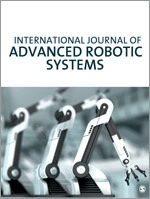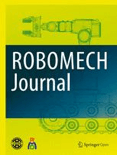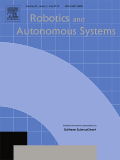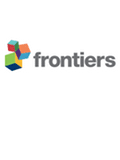
Artificial Life and Robotics
Scope & Guideline
Bridging Theory and Practice in Robotics Research
Introduction
Aims and Scopes
- Biomimetic Robotics:
Research on robots that emulate biological systems, focusing on locomotion, sensory processing, and adaptive behaviors, such as snake locomotion or soft robotics inspired by octopi. - Artificial Intelligence and Machine Learning:
Development and application of AI techniques, including reinforcement learning, neural networks, and genetic algorithms, to enhance robotic capabilities and decision-making processes. - Human-Robot Interaction:
Exploration of how robots can interact with humans in various contexts, including emotional recognition, assistive technologies, and teleoperation, to improve user experience and collaboration. - Computer Vision and Sensing Technologies:
Innovative approaches to perception and sensing in robots, including object detection, tracking, and environmental mapping using advanced imaging and sensor technologies. - Swarm Robotics:
Studies focusing on collective behavior in robotic swarms, addressing coordination, communication, and emergent behaviors in multi-robot systems. - Robotic Control Systems:
Research on control methodologies for robots, including adaptive control, PID control, and novel feedback systems to enhance performance in dynamic environments. - Applications in Health and Safety:
Application of robotics and AI in healthcare and safety, including monitoring systems, assistive devices for the elderly, and tools for medical diagnostics.
Trending and Emerging
- Soft Robotics and Flexible Systems:
Increasing focus on soft robotics that utilize flexible materials and designs to achieve adaptability and functionality similar to biological organisms. - AI-Driven Autonomous Systems:
A surge in research related to autonomous systems powered by advanced AI algorithms, particularly in applications such as autonomous vehicles and drones. - Human Augmentation and Assistive Technologies:
Emerging studies on technologies that enhance human capabilities, including wearable devices and collaborative robots designed to assist individuals in various tasks. - Robotics in Healthcare and Rehabilitation:
Growing interest in the application of robotics in healthcare settings, particularly for rehabilitation, surgery, and elderly care, emphasizing the role of robots in improving patient outcomes. - Environmental Monitoring and Disaster Response:
Research exploring the use of robotics for environmental monitoring, including disaster response scenarios, reflecting a commitment to applying technology for societal benefit. - Neuroscience-Inspired Algorithms:
Emerging themes in neuroscience-inspired computational models and algorithms that enhance the learning and adaptability of robotic systems, drawing parallels with biological processes.
Declining or Waning
- Traditional Mechanical Robotics:
Research focusing exclusively on traditional mechanical systems is declining as interest shifts towards more adaptive, biologically inspired designs and soft robotics. - Basic Algorithmic Studies:
Papers solely focused on foundational algorithm development without application to robotics or AI have seen a decrease, as the journal emphasizes applied research with tangible outcomes. - Static Environmental Interaction:
Research on robots operating in static, controlled environments is waning in favor of studies that explore dynamic, real-world interactions, such as those involving human subjects or unpredictable environmental conditions. - Low-level Control Mechanisms:
Interest in low-level control mechanisms without integration into higher-level cognitive functions or learning systems is diminishing, reflecting a trend towards more sophisticated, intelligent control systems.
Similar Journals

International Journal of Advanced Robotic Systems
Transforming Ideas into Robotic RealitiesThe International Journal of Advanced Robotic Systems is a premier academic journal, published by SAGE Publications Inc., dedicated to fostering innovation and research in the rapidly evolving field of robotics. With an ISSN of 1729-8814, this Open Access journal has been providing unrestricted access to cutting-edge research since 2004, making it an invaluable resource for researchers, professionals, and students alike. The journal aims to disseminate high-quality, peer-reviewed articles that cover a wide range of topics, including but not limited to robotic systems, automation, artificial intelligence, and sensor technologies. By promoting interdisciplinary collaboration and encouraging novel approaches, the International Journal of Advanced Robotic Systems plays a crucial role in advancing the frontiers of robotics and ensuring its impactful application across various industries. Engaging with this journal not only keeps you at the forefront of the latest developments but also contributes to the global discourse on robotics and its advancements in science and technology.

Studies in Informatics and Control
Illuminating the Path of Informatics and ControlStudies in Informatics and Control is a distinguished academic journal published by the NATL INST R&D INFORMATICS-ICI, specializing in the interdisciplinary fields of Computer Science and Electrical and Electronic Engineering. With an ISSN of 1220-1766 and a recognized standing within its field, this journal aims to foster innovation and disseminate high-quality research findings from 2010 through 2024. It maintains a significant presence in the academic landscape, holding a Q3 ranking in both Computer Science (miscellaneous) and Electrical and Electronic Engineering categories for 2023, which underscores its commitment to advancing knowledge and technology in these areas. While the journal is not open access, it provides valuable insights and results that are essential for researchers, professionals, and students striving to develop their expertise in informatics and control systems. Based in Romania, its contributions traverse international boundaries, appealing to a global audience keen on the latest developments and trends within these rapidly evolving fields.

ROBOTICA
Connecting Minds in Robotics and Artificial IntelligenceROBOTICA is a premier academic journal that serves as a vital resource within the multidisciplinary field of robotics and artificial intelligence. Published by Cambridge University Press, this journal boasts a comprehensive scope that encompasses areas such as computational mechanics, computer vision, control systems, and software applications. With an impressive range of quartile rankings in 2023, including Q2 in key categories like Computational Mechanics and Control and Optimization, ROBOTICA represents a significant contribution to its field, providing researchers and practitioners with cutting-edge insights and advancements. Although it follows a traditional subscription model, the journal maintains a commitment to accessibility through its esteemed indexing performance and robust academic standing, evidenced by Scopus rankings within the top percentiles across multiple relevant disciplines. Covering an expansive period from 1983 to 2024, ROBOTICA is essential for anyone looking to stay at the forefront of robotics research and innovation.

Soft Robotics
Transforming Robotics through Bio-Inspired Design and Insight.Soft Robotics, published by MARY ANN LIEBERT, INC, stands as a leading journal dedicated to advancing the field of soft robotics, which merges insights from artificial intelligence, biophysics, and control systems engineering to innovate in areas such as bio-inspired design, human-robot interaction, and flexible robotics. With a distinguished Q1 ranking in multiple categories, including Artificial Intelligence, Biophysics, and Control and Systems Engineering, this journal places itself at the cutting edge of interdisciplinary research, boasting impressive Scopus rankings that reflect its rigorous scholarship and influential contributions to the scientific community. Although it is not an open access journal, it provides valuable insights and findings for researchers, professionals, and students eager to explore the transformative potential of soft robotics in practical applications. The journal has published continuously since its inception in 2014, and will continue to converge between theory and application through 2024, emphasizing its commitment to expanding the frontiers of knowledge in this dynamic field. For those engaged in the exploration of robotics technologies shaped by soft materials and adaptive mechanisms, Soft Robotics is an essential resource that fuels innovation and discovery.

Journal of Robotics Networking and Artificial Life
Transforming Knowledge into Action in Networking and Robotics.Journal of Robotics Networking and Artificial Life, published by ALife Robotics Corp Ltd, stands at the forefront of interdisciplinary research at the intersection of robotics, artificial intelligence, and networking, representing a vital resource for scholars and practitioners in these rapidly evolving fields. Established as an Open Access journal since 2014, it provides unrestricted access to cutting-edge research and innovative methodologies, fostering collaboration and knowledge dissemination globally. Although it currently holds a Q4 ranking in both Artificial Intelligence and Computer Networks and Communications, its commitment to advancing knowledge through robust peer review and dedicated publication practices positions it as a growing contender within these spheres. With a publication history covering the years from 2019 to 2023, this journal emphasizes the importance of novel insights and cross-disciplinary approaches. Researchers, professionals, and students are encouraged to contribute to and engage with the evolving discourse in robotics and artificial intelligence, making the Journal of Robotics Networking and Artificial Life an essential addition to their academic and professional resources.

ROBOMECH Journal
Connecting Scholars and Innovators in Robotics and AIROBOMECH Journal, published by SpringerNature, is a prominent open-access journal dedicated to the fields of robotics, mechanical engineering, and artificial intelligence. Established in 2014, the journal has quickly established itself as a vital platform for disseminating innovative research in control and optimization, instrumentation, and modeling and simulation, earning a commendable Q2 ranking in Mechanical Engineering and multiple Q3 rankings across other relevant fields in 2023. With a commitment to facilitating accessible knowledge sharing, ROBOMECH Journal promotes cutting-edge research that drives advancements in both theoretical frameworks and practical applications within the robotics community. Scholars, engineers, and professionals seeking to contribute to or stay informed about the latest developments in these dynamic fields will find the journal's rich array of articles invaluable. With its open-access model, all published research is freely available, ensuring wide dissemination and increased visibility for authors, thus fostering collaboration and innovation across disciplines.

International Journal of Intelligent Robotics and Applications
Pioneering Research in Robotics and AI ApplicationsInternational Journal of Intelligent Robotics and Applications, published by SPRINGER SINGAPORE PTE LTD, is a pivotal platform dedicated to advancing the field of robotics and artificial intelligence. With an ISSN of 2366-5971 and an E-ISSN of 2366-598X, this journal has established its presence since its inception in 2017, showcasing innovative research and applications up until 2024. The journal aims to foster interdisciplinary collaboration by publishing high-quality articles that cover a broad range of topics from foundational AI concepts to cutting-edge robotics technologies. It holds respectable rankings, positioned in the Q3 category of Artificial Intelligence and Q2 category of Computer Science Applications in the 2023 metrics, and is indexed in Scopus with notable rankings in both computer science disciplines. Although it follows a subscription model, the journal remains committed to facilitating access to groundbreaking research for its audience of researchers, professionals, and students, contributing to the ever-evolving landscape of intelligent robotics.

Industrial Robot-The International Journal of Robotics Research and Application
Exploring Innovations in Automation and RoboticsIndustrial Robot-The International Journal of Robotics Research and Application is a premier academic journal published by Emerald Group Publishing Ltd in the United Kingdom. Since its inception in 1973, the journal has established itself as a critical resource for the advancement of knowledge in the fields of robotics and automation. With an impressive Q2 ranking across several categories, including Computer Science Applications, Control and Systems Engineering, and Industrial and Manufacturing Engineering, it places itself among the top-tier journals in its domain. The journal aims to disseminate high-quality research that addresses contemporary challenges and innovations in robotics, thereby supporting both academic inquiry and practical applications in industry. Researchers, professionals, and students are encouraged to contribute to its mission, as it remains vital for those seeking to engage with the ever-evolving landscape of robotic technologies.

ROBOTICS AND AUTONOMOUS SYSTEMS
Exploring Innovations in Robotics and Autonomy.ROBOTICS AND AUTONOMOUS SYSTEMS, published by Elsevier, is a leading journal in the fields of robotics and automation, providing a platform for the dissemination of high-quality, peer-reviewed research. With an impressive impact factor and a prestigious reputation, this journal is classified in the Q1 category for major fields including Computer Science Applications, Control and Systems Engineering, Mathematics, and Software as of 2023. The journal boasts an extensive archive dating back to 1988, reflecting the evolution of the discipline and fostering innovative research discussions that are crucial for advancements in autonomous technologies. Researchers, professionals, and students are encouraged to contribute to and benefit from the ongoing dialogue within these dynamic fields. Accessible through various academic resources, ROBOTICS AND AUTONOMOUS SYSTEMS stands as a pivotal information source for those dedicated to exploring the frontiers of intelligent systems.

Frontiers in Neurorobotics
Exploring Neural Mechanisms to Transform RoboticsFrontiers in Neurorobotics is a leading open access journal that bridges the fields of artificial intelligence and biomedical engineering, dedicated to advancing the understanding and application of neural mechanisms in robotics. Published by FRONTIERS MEDIA SA in Switzerland, this journal has been disseminating innovative research since its inception in 2007. With an aim to foster interdisciplinary collaboration and share cutting-edge findings, Frontiers in Neurorobotics holds a commendable position in the academic landscape, ranking in the Q2 category for both Artificial Intelligence and Biomedical Engineering as of 2023. Researchers will find it particularly valuable due to its broad scope, which encompasses everything from theoretical frameworks to practical applications in neurorobotics. The journal is committed to open access, ensuring that its contents are readily available to a global audience, thus enhancing visibility and engagement with trailblazing research in this dynamic field.